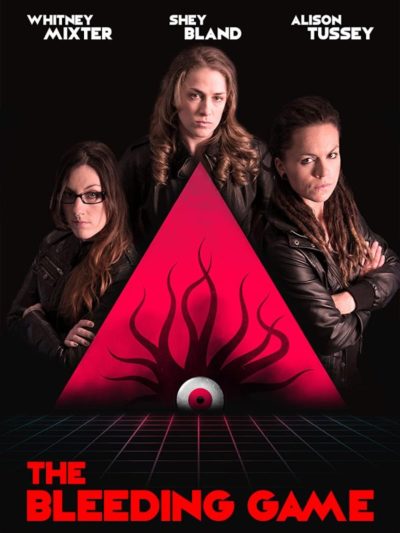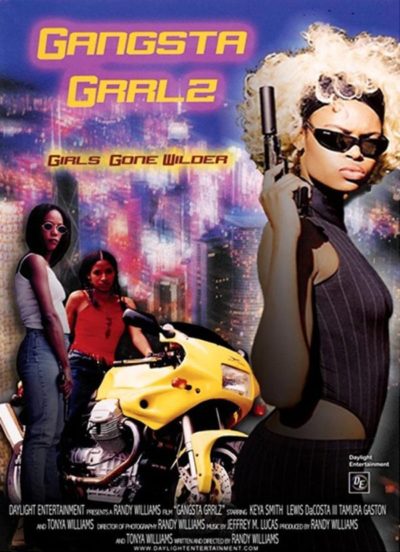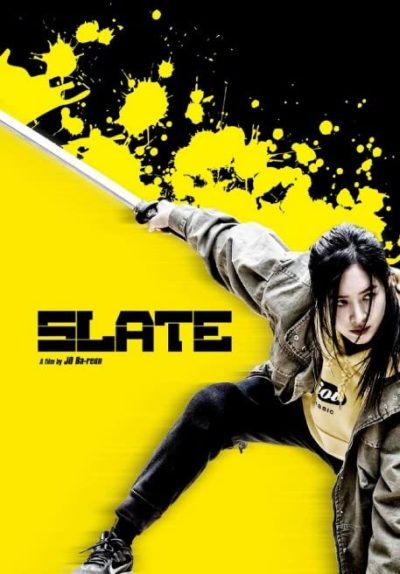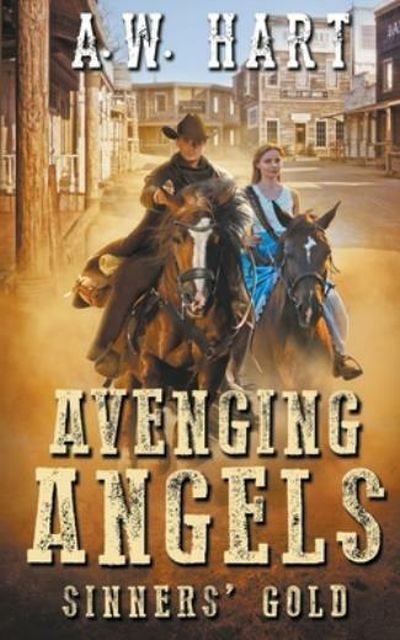★½
“Bleeding terrible, innit?”
 It is possible to do Lovecraft on a low-budget and make it work. Earlier this year, I was introduced to the delightful films of Lars Henriks, who did a whole trilogy of micro-budget movies, loosely in the Lovecraft universe. Taken in the right spirit, they’re quite charming. Then, there’s this… I think I can safely say, it’s neither delightful nor charming, regardless of spirit. The best I can say is there is a non-terrible core concept here. Mr. Temple (Bolton) wants occult power, and feeds on blood, so summons a trio of Shoggoths, mystical minions who possess a sleazy businessman, a metalhead, and a rent boy. They prey on the women who frequent his bars, bringing their essence back to their master. Arrayed against him are three sisters (one adopted), the Proctors: Aida (Mixter), Flo (Bland) and Lizzy (Alison), who come from a family of white magicians. When the corpses of the Shoggoth’s victims start piling up, they seek to stop first them, then Temple, from continuing their dark harvest.
It is possible to do Lovecraft on a low-budget and make it work. Earlier this year, I was introduced to the delightful films of Lars Henriks, who did a whole trilogy of micro-budget movies, loosely in the Lovecraft universe. Taken in the right spirit, they’re quite charming. Then, there’s this… I think I can safely say, it’s neither delightful nor charming, regardless of spirit. The best I can say is there is a non-terrible core concept here. Mr. Temple (Bolton) wants occult power, and feeds on blood, so summons a trio of Shoggoths, mystical minions who possess a sleazy businessman, a metalhead, and a rent boy. They prey on the women who frequent his bars, bringing their essence back to their master. Arrayed against him are three sisters (one adopted), the Proctors: Aida (Mixter), Flo (Bland) and Lizzy (Alison), who come from a family of white magicians. When the corpses of the Shoggoth’s victims start piling up, they seek to stop first them, then Temple, from continuing their dark harvest.
I should have recognized the director’s name: I’m presuming he’s the brother (or something) of Sean-Michael Argo. That is the Argo who gave us one of the worst ever action-heroine films in Iconoclast. He shows up here as The Grin, an Oracle-like figure to whom the Proctor sisters turn for advice. His relative Ian is, at least, able to tell a coherent story, so that puts him well ahead of his relative. However, there are still way too many problem present for this to be successful, even by the low-standards of incredibly cheap horror. The audio is inconsistent from scene to scene, varying from muffled to incredibly echoey. The pacing is terrible, with scenes that serve no real purpose, and the backstory involving their father is murky, at best. Though I was quite amused by the way that shotguns are basically more effective than any traditional tools, and there is a half-decent impalement.
My biggest complaint, however, was the flat-out terrible British accents sported by the Shoggoths. I’m not sure why being taken over by a demonic entity causes the victims suddenly to channel Dick Van Dyke from Mary Poppins, but here we apparently are. I feel personally attacked by this blatant example of Britwashing, not least since it’s an accent that serves absolutely no purpose whatsoever, any more than the top hat sported by one Shoggoth. The film is at its best least worst when they aren’t speaking on screen, simply because I no longer had a rising desire to put my fist, the living-room table or our cat through the television. Even writing this paragraph is sending my blood pressure spiking. The sisters don’t bother with fake accents, and occasionally border on being interesting characters: looks like two of them have an on/off sexual relationship, though we cut away from ever seeing anything there. Like the rest of the film, that demonstrates its disappointing failure to deliver.
Dir: Ian Argo
Star: Whitney Mixter, Shey Bland, Alison Tussey, C. Jason Bolton





 Not to be confused with the clearly different
Not to be confused with the clearly different  Well, this is certainly the first film I’ve reviewed here which drops both into the “women in prison”
Well, this is certainly the first film I’ve reviewed here which drops both into the “women in prison”  This is a fairly classic “rise from nowhere” story, yet is well-executed and done in a world which is interesting for its differences. The heroine is – surprise! – Marilia, whom we first meet on the battlefield, about to face an opponent of superior numbers. We then flash back to her childhood, growing up in a Tyracian brothel. Her mother was one of the “painted ladies,” but after she dies, Marilia and her brother Annuweth are on increasingly thin ice. Their effort to run away is unsuccessful, yet does bring them a chance at a new life. While it’s here that Marilia discovers her tactical savvy through board games, it’s not without its downside, the siblings being split up after Marilia enters an arranged marriage in another territory.
This is a fairly classic “rise from nowhere” story, yet is well-executed and done in a world which is interesting for its differences. The heroine is – surprise! – Marilia, whom we first meet on the battlefield, about to face an opponent of superior numbers. We then flash back to her childhood, growing up in a Tyracian brothel. Her mother was one of the “painted ladies,” but after she dies, Marilia and her brother Annuweth are on increasingly thin ice. Their effort to run away is unsuccessful, yet does bring them a chance at a new life. While it’s here that Marilia discovers her tactical savvy through board games, it’s not without its downside, the siblings being split up after Marilia enters an arranged marriage in another territory. This is a prequel of sorts to
This is a prequel of sorts to  This is definitely an interesting idea, and potentially the most meta action heroine film I’ve seen. Cha Yeon-hee (Ahn) has wanted to be a movie heroine ever since she was a child, though it’s an ambition which has always eluded her – in part because of her refusal to work her way up in the industry. She eventually and grudgingly accepts a stunt double position in a historical swordplay film, and shows up on the set for her first day. However, due to circumstances involving a magical clapperboard (hence the title) and an inconvenient portal, she finds herself transported to a parallel dimension. It’s kinda like modern Korea in clothes and speech, but run by warlords and their sword-carrying minions.
This is definitely an interesting idea, and potentially the most meta action heroine film I’ve seen. Cha Yeon-hee (Ahn) has wanted to be a movie heroine ever since she was a child, though it’s an ambition which has always eluded her – in part because of her refusal to work her way up in the industry. She eventually and grudgingly accepts a stunt double position in a historical swordplay film, and shows up on the set for her first day. However, due to circumstances involving a magical clapperboard (hence the title) and an inconvenient portal, she finds herself transported to a parallel dimension. It’s kinda like modern Korea in clothes and speech, but run by warlords and their sword-carrying minions. Made on a shoestring in Ireland, the nicest thing you can say is probably, this doesn’t look as cheap as it was. If only you could say the same for the script, which seems to be trying to be Guy Ritchie, only to end up nearer to Guy Fieri. It’s not a terrible idea, if rather stretching belief. Katelin Ballantine (Doherty) is a film producer, trying to raise funds for her latest movie. To that end, she is hanging out, unwillingly, with sleazeball businessman, Felim Shaw. What she doesn’t know, is he is deep in debt to local mob-boss Edmund Murren (Fleming). He kidnaps them both, forces Katelin to kill her potential investor, then threatens her family to make her continue in her new career as his assassin, alongside former friend and now Murren associate, Henry Furey (Kealy).
Made on a shoestring in Ireland, the nicest thing you can say is probably, this doesn’t look as cheap as it was. If only you could say the same for the script, which seems to be trying to be Guy Ritchie, only to end up nearer to Guy Fieri. It’s not a terrible idea, if rather stretching belief. Katelin Ballantine (Doherty) is a film producer, trying to raise funds for her latest movie. To that end, she is hanging out, unwillingly, with sleazeball businessman, Felim Shaw. What she doesn’t know, is he is deep in debt to local mob-boss Edmund Murren (Fleming). He kidnaps them both, forces Katelin to kill her potential investor, then threatens her family to make her continue in her new career as his assassin, alongside former friend and now Murren associate, Henry Furey (Kealy). I’ve mentioned before the general lack of action-heroine films for the pre-teenage crowd:
I’ve mentioned before the general lack of action-heroine films for the pre-teenage crowd:  Within ten seconds of Chris having entered the room when this was on, she asked, “Are you watching Moonlighting?” No, I wasn’t – but it’s certainly a valid question. Just a couple of years earlier, Shepherd had finished off a run playing a private eye alongside Bruce Wills on that highly successful show. And here she is, again playing a private investigator on television, with a fondness for cracking wise and showing off her legs. What
Within ten seconds of Chris having entered the room when this was on, she asked, “Are you watching Moonlighting?” No, I wasn’t – but it’s certainly a valid question. Just a couple of years earlier, Shepherd had finished off a run playing a private eye alongside Bruce Wills on that highly successful show. And here she is, again playing a private investigator on television, with a fondness for cracking wise and showing off her legs. What  “A. W. Hart,” the nominal author of the Avenging Angels series, is actually a house pen name used by Wolfpack Publishing for the multiple authors of this and one or two of their other series. Where books are marketed or shelved by the author’s name, this device allows a series to be kept together. It also makes it possible for the same main character(s) to be featured in a number of adventures, without being limited to the imagination or time constraints of a single author.
“A. W. Hart,” the nominal author of the Avenging Angels series, is actually a house pen name used by Wolfpack Publishing for the multiple authors of this and one or two of their other series. Where books are marketed or shelved by the author’s name, this device allows a series to be kept together. It also makes it possible for the same main character(s) to be featured in a number of adventures, without being limited to the imagination or time constraints of a single author.